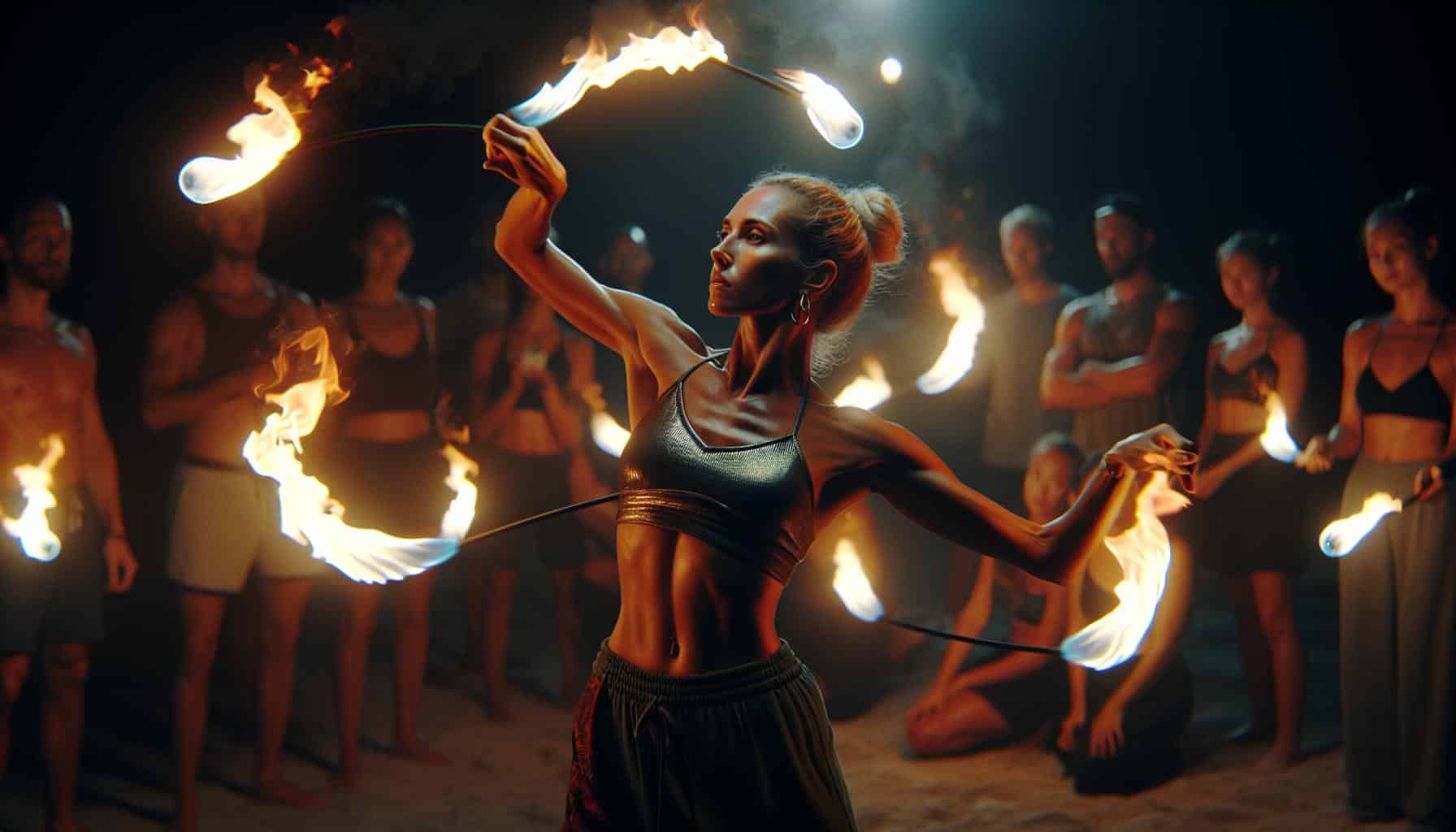Imagine standing on the beach, the sun has just set and you’re surrounded by the rhythmic sounds of the waves and drums. Suddenly, the darkness is pierced by a mesmerizing dance of fire. You’re about to embark on a journey into the world of firedancing, a captivating art form that blends dance, athleticism, and the primal allure of fire.
This ancient practice, steeped in tradition, is not just about the spectacle. It’s a dance of courage, discipline, and precision. Join us as we delve deeper into the fiery world of firedancing, exploring its history, techniques, and the fearless artists who dare to dance with the flames.
History of Fire Dancing
Delving into the profound past, fire dancing takes root in the age-old customs sprinkled across diverse landscapes worldwide.
Origins and Cultural Significance
Fire dancing’s genesis can be traced back to age-old Polynesian communities, predating recorded history. Known more traditionally as ‘poi’, a training tool for war, the esteemed Maori people from New Zealand exemplify a vivid manifestation of ancient fire dancing. Poi not only prepared warriors for battle by improving wrist flexibility and strength, but it also served as a potent story-telling tool. The moral tales spun around the fire glorified folklore heroes, binding communities together in shared history and values.
Many ancient societies, prominently those dwelling in regions such as Africa, the Pacific islands, and Hawaii, discerned fire as a transformative natural force, representing life, death, and rebirth. Fire dancers were deemed spiritual intermediaries, their energetic moves believed to invoke divine benevolence. Their performances reaffirmed the critical link between humans and nature, assuming a ceremonious role in tribal gatherings.
Meticulously falling into step, the culturally-significant fire dances encompassed traditional instruments and intuitive music, each beat summoning ancestors’ spirit and wisdom, marking the path for future generations.
Evolution of Fire Dancing Styles
As societies evolved, fire dancing assimilated elements from diverse cultural practices, cocooning into a fascinating hybrid form it resonates as today. Larger fire implements, the incorporation of acrobatics, and tailored music routines metamorphosed fire dancing into an orchestrated ritual of grace and flame. It isn’t surprising that fire dancing found a unique place in the roster of contemporary performing arts where firedancers showcase intricate maneuvers and captivating exploits.
The 20th-century wave of globalization further amplified the evolution of these fire-lit performances, including fire staff juggling, fire knife dancing, and fire hula hoop dancing. Festivals such as Burning Man and Thailand’s Full Moon parties now offer global platforms for modern fire dancers, encompassing traditional skills within innovative interpretations.
Various circus troupes, burlesque shows, and street performances incorporate different styles of fire dancing, evolving this ancient art form into a reflective mix of traditional customs and modern interpretative dance. As such, fire dancing has become a vibrant cross-cultural phenomenon, resonating with audiences worldwide and representing a dance discipline that is as unpredictable and captivating as the flames it tames.
In essence, the fire dancing history offers an insightful glimpse into the evolution of cultural practices, reaffirming the fact that art forms–like the embers they toy with–continue to reinvent themselves, keeping their intrinsic vitality undiminished.
Essential Equipment for Fire Dancers

Fire dancing, often called “firedancing,” requires absolute precision, skill, and adequate equipment. This combination of culture, art, and performance obliges performers to have certain types of fire props and safety equipment to ensure an impactful and safe performance.
Types of Fire Props
Fire dancers use a variety of fire props each with its distinct purpose and style. Some examples:
- Fire Poi: Originating from the Maori people of New Zealand, fire poi involves swinging tethered weights that have a flame at one end. Created from a chain with a handle at one end and Kevlar wicking material soaked in fuel at the opposite end, fire poi generates mesmerizing fire trails.
- Fire Staff: A more straightforward fire prop, a fire staff is a long rod made of metal or wood with fire wicks soaked in fuel attached at either end. Dancers spin fire staffs around their bodies, creating visual displays of fire circles.
- Fire Fans: These consist of multiple spokes, typically five, with wicks attached at each end, forming a fan silhouette—dancers grip them at the base and manipulate them to generate flame patterns.
- Fire Hoops: A fusion of traditional hula hooping and firedancing, fire hoops feature several flaming spokes around the hoop’s periphery, offering a spectacular visual effect when spun.
Safety Gear and Precactions
Fire dancing may be beautiful and captivating, but it’s not without its inherent dangers. Taking precautions and using appropriate safety gear remains critical to a fire dancer’s routine. Let’s look at some mandatory safety gear and precautions:
- Fire Blankets: Often made of fire-resistant materials like fiberglass or aramid fiber, fire blankets can extinguish flames on props and put out accidental fires on clothing or skin.
- Fire Extinguishers: A must-have for any fire performance, performers often keep these versatile devices nearby as a quick-response measure in case of a sizeable uncontrolled fire.
- Safety Clothing: Fire dancers typically wear clothing made from natural fibers like cotton or wool as they’re less susceptible to catching fire compared to synthetic materials. Fire-resistant clothing allows for easier control of stray embers.
- Training and Practice: Fire dancers need thorough training and consistent practice. They must know how to immediately react to any unexpected events during their performance.
- Sober Performance: Fire dancers avoid alcohol or any mind-altering substances. A clear, focused mind allows for better coordination when manipulating fire props.
Remember, fire dancing isn’t just about the spectacle—it’s about mastering the art responsibly. Regularly checking your safety gear and keeping up with training are as crucial as the dance itself. This equipment, along with a respect for the fire you control, not only ensures a spectacular performance but also helps preserve the integrity and the future of the vibrant culture of fire dancing.
Learning the Art of Fire Dancing
Finding Classes and Workshops
To elevate your fire dancing skills, locating reliable classes or workshops becomes a crucial step. These training avenues can exist in various formats such as in-person, online, or hybrid models offering flexibility to learners.
Local specialists might provide face-to-face tutorials, providing you firsthand observation of techniques and instant feedback to your performances. You might stumble upon dance centers or studios that offer fire dancing tutorials as part of their curriculum. Festivals that celebrate fire arts often host workshops where experienced fire dancers instruct newcomers and intermediate dancers.
Online resources also present robust avenues to learn, especially if physical locations are scarce in your vicinity. Websites like Flow Arts Institute host instructional videos and courses covering a broad spectrum of fire dancing skills.
Self-Taught Fire Dancing: Tips and Resources
In circumstances where you opt to become a self-taught fire dancer, several tips can accentuate your learning process. Moreover, numerous resources sit at your disposal.
It’s essential to harness educational resources online. Websites such as Home of Poi offer extensive tutorial videos covering the basics and advanced techniques of fire dancing. YouTube also proves a valuable resource, teeming with instructional videos from professionals across the globe.
Joining social media groups and forums involving fire dancers can provide unique insights into the art, along with real-time trends and tips. Platforms such as Reddit have active fire dancing communities wherein members indulge in meaningful conversations and share valuable content.
Irrespective of the learning method you choose, it’s vital to be patient and consistent. Fire dancing demands immense practice and perseverance. Always remember to keep safety protocols in mind, given the risk element inherently attached to this art.
Prominent Fire Dancers and Performances
Given the rich history and evolving techniques in fire dancing, certain dancers and performances have notably made their mark in the industry. You’ll discover influential fire dancers and memorable fire dancing events throughout the world that have significantly contributed to the proliferation and appreciation of this art form.
Influential Fire Dancers to Know
Fame in fire dancing doesn’t come easy. It requires a culmination of skill, passion, and consistent practice. Here are a few renowned individuals who’ve ascended to prominence in this field, turning fire dancing into a stunning spectacle.
- Sophie Thomas, known as the “fire fairy,” captivates audiences with her grace and precision. Her expertise alongside her passion for environmental issues marks her as a unique gem in the industry.
- Jason Divad embodies the spirit of fire dancing with his intense control and choreography. With years of rigorous training, he’s made a name in numerous fire dance festivals.
- Yuta Imamura, a visionary hailing from Japan, pushes the boundaries of traditional fire dancing. His incorporation of martial arts into his routines showcases the potential and adaptability of fire dancing.
Each of these artists has contributed to broader recognition and a deeper understanding of fire dancing’s potential.
Memorable Fire Dancing Events Worldwide
Like the riveting performances of individual dancers, various events globally hold testament to the growing appeal of the fire dancing human spectacle. Here are a few memorable events:
- Beltane Fire Festival, Edinburgh – Held annually in April, this event witnesses a vibrant collision of history and artistry, epic in scale and striking in performance.
- Transformus, North Carolina – An event built around the principles of self-expression and participation, Transformus fosters a robust fire dancing culture.
- AfrikaBurn, South Africa – A momentous festival in the heart of the desert, AfrikaBurn leaves spectators spellbound with artistic installations and fire performances.
These events shine a spotlight on the brilliance of fire dancing, showcasing how skill, artistic vision, and spectacle blend into a truly memorable experience.
Conclusion
Fire dancing isn’t just about the spectacle. It’s a rich art form with deep roots and a vibrant global community. As you’ve seen, it requires dedication, practice, and a deep respect for the craft. Whether you’re drawn to the artistry of performers like Sophie Thomas, Jason Divad, and Yuta Imamura, or inspired by the energy of events like the Beltane Fire Festival, Transformus, or AfrikaBurn, there’s a place for you in this world. Remember, learning resources are abundant, from classes to online tutorials. So, if you’re ready to embrace the flame and dance, the path is open. It’s more than a hobby; it’s a journey into a tradition that spans across cultures and centuries. Embrace it, respect it, and most importantly, enjoy it.
What is the history of fire dancing?
Fire dancing has ancient origins and has evolved significantly over time. Emphasized in this progress are the essential equipment required and safety measures needed for practitioners.
How can an individual learn fire dancing?
An individual can learn fire dancing through various methods including attending classes, joining workshops, and leveraging online resources. There are also tips provided for self-teaching.
Who are some notable fire dancers?
Sophie Thomas, Jason Divad, and Yuta Imamura are prominent fire dancers. Each has contributed to fire dancing by enhancing it with their unique styles.
What are some global fire dancing events?
Key fire dancing events happen world over – the Beltane Fire Festival in Edinburgh, Transformus in North Carolina, and AfrikaBurn in South Africa. These events highlight the global appeal and artistic richness of fire dancing.








